WinFly
Arriving at WinFly in McMurdo Station is a really special experience. For those keeping track at home, you will remember that WinFly is short for Winter Fly-In. The USAP(abbreviation) United States Antarctic Program flies just a few flights into McMurdo in mid-August to provide some extra personnel and cargo to help get McMurdo Station ready for "main body", the large group of workers and scientists who will arrive in October for the Antarctic summer. This WinFly group joins the small group of scientists and workers who wintered over, or stayed at McMurdo Station all winter long. This WinFly has been a challenge. The first two flights arrived safely and on schedule. There are six or seven flights scheduled for this WinFly. Several of the flights are delayed and I really feel for all those weary travelers who are in Christchurch, waiting to get to McMurdo.
WinFly is a tremendous time to be in McMurdo because of the amazing weather and the rapid seasonal change that occurs. Also, many departments and people are just gearing up for the season and are full of energy and enthusiasm. There's a lot of work to be done, getting equipment out of storage and running. Everyone has been incredibly helpful!

So, let's take a look at what's happening with the seasons down here in McMurdo.
Seasons and Daylight
Let's start with the season. Do you know why we have seasons on Planet Earth? There are two reasons: 1) the Earth is tilted and 2) the Earth revolves (goes around) the Sun. Here's a picture that shows both:
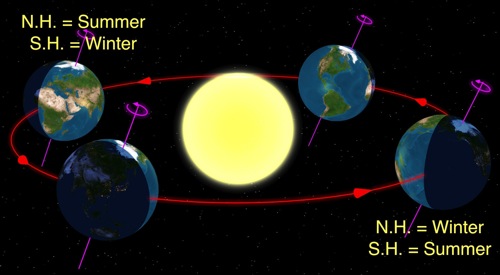
If the diagram isn't helping you to understand, try this animation. Click here
When we left Delaware, we were enjoying summer, the Earth was in the position on its trip around the Sun, where the Northern Hemisphere was tilted toward the Sun. Temperatures were in the 80˚F range and we had long days (over 13 hours of daylight). Since Antarctica is in the Southern Hemisphere, its seasons are opposite. When the Earth is in position for the Northern Hemisphere's summer, the Souther Hemisphere is tilted away from the Sun. So, we have arrived at the end of McMurdo's winter. The temperatures are likely to be cold. August averages -18˚F at McMurdo Station. On average, this is one of McMurdo Station's colder months.
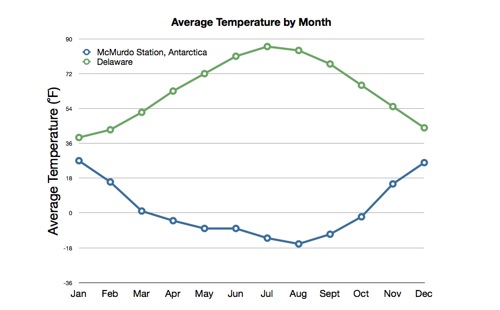
What do you notice when you look at this graph? How do Delaware (green) and McMurdo Station (blue) compare in temperature throughout the year? When are Delaware's warmest months? When are McMurdo's warmest months?
We are also not seeing as much daylight as we would in Delaware. Today, for example, we experienced about 4 hours of daylight. It is brightest from about 11 AM to 2 PM, but it never gets really bright. It's more like a sunrise or sunset light in terms of intensity or strength.
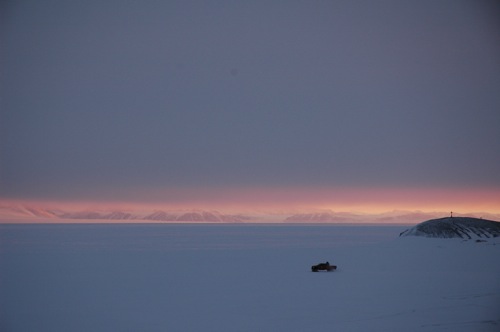
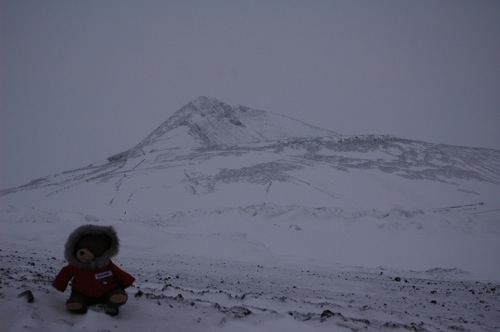
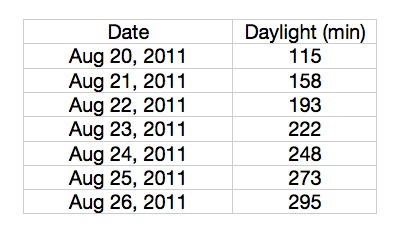
When you look at the data in the table above, what patterns do you notice? Stop and really look at it. Go ahead, I'll wait.
When I look at the data, there is a pattern that jumps out at me. Even though we don't get much light, nor is it very intense, we are gaining a large amount of daylight time to each day. Back home in Delaware, when we are approaching summer, we gain about 2 minutes more of daylight each day. At McMurdo Station, we are gaining almost 30 minutes of sunlight more than yesterday. That's a dramatic difference! It's happening because we're changing from winter to summer. In just a few weeks, all our outdoor photos will be sunny!
By the way, a reader pointed out something very interesting from yesterday's post. Did you notice the South Pole sunrise time? Here's another chance.
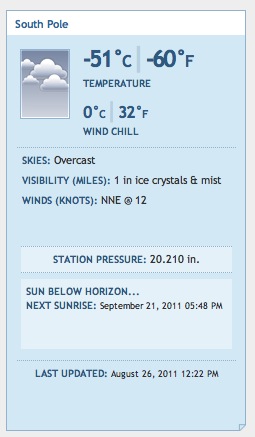
What do you think that means for folks working at the South Pole? That's right - it's dark there all 24 hours of the day. They won't see the Sun for another three weeks. Before you start feeling too badly, think about this. If it's dark there all day because they are tilted away from the Sun, what is going to happen when the Earth revolves around the Sun to the point where the South Pole is tilted toward the Sun?
P.S. As the seasons change here at McMurdo, they also change in the Northern Hemisphere. If we are going from winter to spring, Delaware must be going from summer to autumn. That means the start of school! A special shout out to Dr. Marsh's son, Anson, who is starting his college career today. Good luck, Anson!


Comments